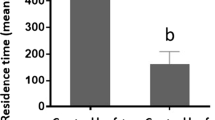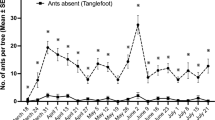Abstract
We investigated feeding and oviposition behavior of the Asian citrus psyllid, Diaphorina citri, when exposed to the foraging trails of the convergens ladybird beetle, Hippodamia convergens. Diaphorina citri females feeding on citrus leaves directly exposed to the ladybird adults or treated with trail extract excreted significantly less honeydew droplets than controls. The trail chemicals of the ladybird beetle also decreased oviposition by D. citri females on citrus. In a no-choice experiment, D. citri females preferred to oviposit on control flush and plants than those with ladybird trail-extract treatments. In two-choice experiments, 68.0% of D. citri released into cages exhibited strong selection preference for settling and eventual oviposition on control plants than plants treated with ladybird trail extract. Diaphorina citri eggs were found on all new leaf flush of control plants, whereas only 29.5% of flush on treatment plants were selected for oviposition. The trail chemical deposited by the convergens ladybird beetle elicits repellency of D. citri feeding and oviposition. Therefore, the trail chemicals my contain components that could be useful for behavior-based management of D. citri and HLB disease by reducing psyllid feeding and oviposition.



Similar content being viewed by others
References
Ammar ED, Ramos JE, Hall DG, Dawson WO, Shatters RG (2016) Acquisition, replication and inoculation of Candidatus Liberibacter asiaticus following various acquisition periods on huanglongbing-infected citrus by nymphs and adults of the Asian citrus psyllid. PLoS One 11(7):e0159594. https://doi.org/10.1371/journal.pone.0159594
Boina DR, Onagbola EO, Salyani M, Stelinski LL (2009) Antifeedant and sublethal effects of imidacloprid on Asian citrus psyllid, Diaphorina citri. Pest Manag Sci 65:870–877
Bové JM (2006) Huanglongbing: a destructive, newly-emerging, century-old disease of citrus. J Plant Pathol 88:7–37
Crabtree RH (1985) The organometallic chemistry of alkanes. Chem Rev 85:245–269
Dixon AFG, Hemptinne JL, Kindlmann P (1997) Effectiveness of ladybirds as biological control agents: patterns and processes. Entomophaga 42:72–83
Doumbia M, Hemptinne JL, Dixon AFG (1998) Assessment of patch quality of ladybird: role of larval tracks. Oecologia 113:197–202
Ferrero D, Lemon J, Fluegge D, Pashkovski S, Korzan W, Datta S, Fendt M, Liberles S (2001) Detection and avoidance of a carnivore odor by prey. Proc R Soc B Biol Sci 108:11235–11240
George J, Ammar ED, Hall DG, Lapointe SL (2017) Sclerenchymatous ring as a barrier to phloem feeding by Asian citrus psyllid: evidence from electrical penetration graph and visualization of stylet pathways. PLoS One 12:e0173520. https://doi.org/10.1371/journal.pone.0173520
Gottwald TR (2010) Current epidemiological understanding of citrus huanglongbing. Annu Rev Phytopathol 48:119–139
Grafton-Cardwell E, Stelinski LL, Stansly PA (2013) Biology and management of Asian citrus psyllid, vector of huanglongbing pathogens. Annu Rev Entomol 58:413–432
Hall DG, Richardson ML, Ammar ED, Halbert SE (2013) Asian citrus psyllid, Diaphorina citri (Hemiptera: Psyllidae), vector of citrus huanglongbing disease. Entomol Exp Appl 146:207–223
Hemptinne JL, Dixon AFG (1991) Why ladybird have generally been so ineffective in biological control? In: Polgar L, Chambers RJ, Dixon AFG, Hodek I (eds) Behavior and impact of Aphidophag. SPB Academic Publishing, The Hague, pp 149–157
Hemptinne JL, Lognay G, Doumbia M, Dixon AFG (2001) Chemical nature and persistence of the oviposition deterring pheromone in the tracks of the larvae of the two spot ladybird, Adalia bipunctata (Coleoptera: Coccinellidae). Chemoecology 11:43–47
Inoue H, Ohnishi J, Ito T, Tomimura K, Miyata S, Iwanami T (2009) Enhanced proliferation and efficient transmission of Candidatus Liberibacter asiaticus by adult Diaphorina citri after acquisition feeding in the nymphal stage. Ann Appl Biol 155:29–36
Magro A, Tene JN, Bastin N, Dixon AFG, Hemptinne JL (2007) Assessment of patch quality by ladybirds: relative response to conspecific and heterospecific larval tracks a consequence of habitat similarity? Chemoecology 17:37–45
Martini X, Dixon AFG, Hemptinne JL (2013) The effect of relatedness on the response of Adalia bipunctata L. to oviposition deterring cues. Bull Entomol Res 103:14–19
Martini X, Kuhus EH, Hoyte A, Stelinski LL (2014) Plant volatiles and density-dependent conspecific female odors are used by Asian citrus psyllid to evaluate host specific suitability on a spatial scale. Arthropod Plant Interact 8:453–460
Michaud JP (2001) Numerical response of Olla v-nigram (Mulsant)(Coleoptera: Coccinellidae) to infestations of Asian citrus psyllid (Hemiptera: Psyllidae) in Florida. Fla Entomol 84:608–612
Michaud J.P. 2004. Natural mortality of asian citrus psyllid (Homoptera: Psyllidae) in Central Florida. Biol. Control. 29:260-269.
Michaud JP, Olsen LE (2004) Suitability of Asian citrus psyllid, Diaphorina citri, as prey for ladybeetles. BioControl 49:417–431
Mowry TM, Ophus JD (2002) Effects of sub-lethal imidacloprid levels on potato leafroll virus transmission by Myzus persicae. Entomol Exp Appl 103:249–255
Nakashima Y, Birkett MA, Pye BJ, Pickett JA, Powell W (2004) The role of semiochemicals in the avoidance of the seven-spot ladybird, Coccinella septempunctata (Coleoptera: Coccinellidae) by the aphid parasitoids, Aphidius ervi (Hymenoptera: Braconidae). J Chem Ecol 30:1103–1115
Nauen R (1995) Behaviour-modifying effects of low systemic concentrations of imidaclorid on Myzus persicae with species reference to an antifeeding response. Pestic Sci 44:145–153
Nauen R, Elbert A (1997) Apparent tolerance of a field-collected strain of Myzus nicotianae to imidacloprid due to strong antifeedant responses. Pestic Sci 49:252–258
Ninkovic V, Feng Y, Olsson U, Petterson J (2013) Ladybird footprints induce aphid avoidance behavior. Biol Control 65:63–71
Oliver TH, Jones I, Cook JM, Leather SR (2008) Avoidance responses of an aphidophagous ladybird Adalia bipunctata, to aphid-tending ants. Ecol Entomol 33:523–528
Patt JM, Sétamou M (2010) Responses of the Asian citrus psyllids, Diaphorina citri (Hemiptera: Psyllidae), to volatiles emitted by the flushing shoots of its rutaceous host plants. Environ Entomol 39:618–624
Patt J.M., Meikle W.G., Mafra-Neto A., Setamou M., Mangan R., Yang C., Malik N., Adamczyk J.J. 2001. Multimodal cues drive host-plant assessment in Asian citrus psyllid (Diaphorina citri). Environ Entomol 40:1494–1502.
Pelz-Stelinski KS, Brlansky RH, Ebert TA, Rogers ME (2010) Transmissoin parameters for Candidatus Liberibacter asiaticus by Asian citrus psyllid (Hemiptera: Psyllidae). J Econ Entomol 103:1531–1541
Roistacher CN (1991) Techniques for biological detection of specific graft transmissible diseases, in Graft-transmissible diseases of Citrus. In: Roistacher CN (ed) Food and agricultural organization. Rome, Italy, p 35–45
Seo M, Rivera MJ, Stelinski LL, Martini X (2018) Ladybird beetle trails reduce host acceptance by Diaphorina citri Kuwayama (Hemiptera: Leviidae). Biol Control 121:30–35
Sétamou M, da Graca JV, Sandoval JL (2016) Suitability of native American Rutaceae to serve as host plants for the Asian citrus psyllid (Hemiptera: Liviidae). J Appl Entomol 140:645–654
Swihart RK, Pignatello JJ, Mattina MIJ (1991) Aversive response of white-tailed deer, Odocoileus virgonianus, to predator urines. J Chem Ecol 17:767–777
Tiwari S, Mann RS, Rogers ME, Stelinski LL (2011) Insecticide resistance in field populations of Asian citrus psyllid in Florida. Pest Manag Sci 67:1258–1268
Tiwari S, Clayson PJ, Kyhns EE, Stelinski LL (2012) Effects of buprofezin and diflubenzuron on various developmental stages of Asian citrus psyllid, Diaphorina citri. Pest Manag Sci 68:1405–1412
Wenniger EJ, Hall DG (2007) Daily timing of mating and age at reproductive maturity in Diaphorina citri (Hemiptera: psyllidae). Fla Entomol 90:715–722
Wenninger EJ, Stelinski LL, Hall DG (2009) Roles of olfactoty cues, visual cues and mating status in orientation of Diaphorina citri Kuwayama (Hemiptera: Psyllidae) to four different host plants. Environ Entomol 38:225–234
Wheeler CA, Cardé RT (2013) Defensive allomones function as aggregation pheromones in diapausing ladybird beetles, Hippodamia convergens. J Chem Ecol 39:723–732
Wheeler CA, Cardé RT (2014) Following in their footprints: cuticular hydrocarbons as overwintering aggregation site markers in Hippodamia convergens. J Chem Ecol 40:418–428
Wheeler CA, Millar JG, Cardé RT (2015) Multimodal signal interactions in the ladybeetle, Hippodamia convergens, aposematic system. Chemoecology 25:123–133
Acknowledgments
We thank Wendy L. Meyer, Angelique B. Hoyte, Kristin A. Racine, and Hunter Gossett for technical support. We really appreciate Timothy A. Ebert for giving the pea aphid for rearing ladybird beetles. This project was supported by the Citrus Research and Development Foundation grant number 15-024.
Author information
Authors and Affiliations
Corresponding author
Ethics declarations
Conflict of Interest
The authors declare that they have no conflict of interest.
Rights and permissions
About this article
Cite this article
Seo, M., Rivera, M.J. & Stelinski, L.L. Trail Chemicals of the Convergens Ladybird Beetle, Hippodamia convergens, Reduce Feeding and Oviposition by Diaphorina citri (Hemiptera: Psyllidae) on Citrus Plants. J Insect Behav 31, 298–308 (2018). https://doi.org/10.1007/s10905-018-9680-2
Revised:
Accepted:
Published:
Issue Date:
DOI: https://doi.org/10.1007/s10905-018-9680-2




